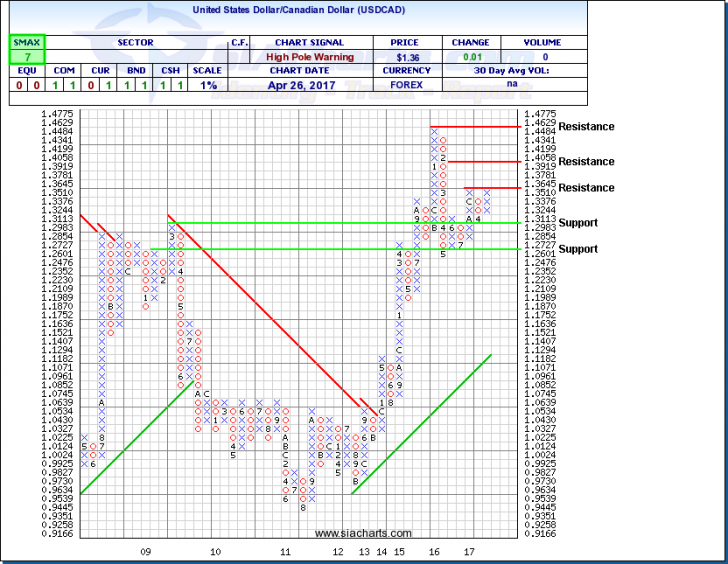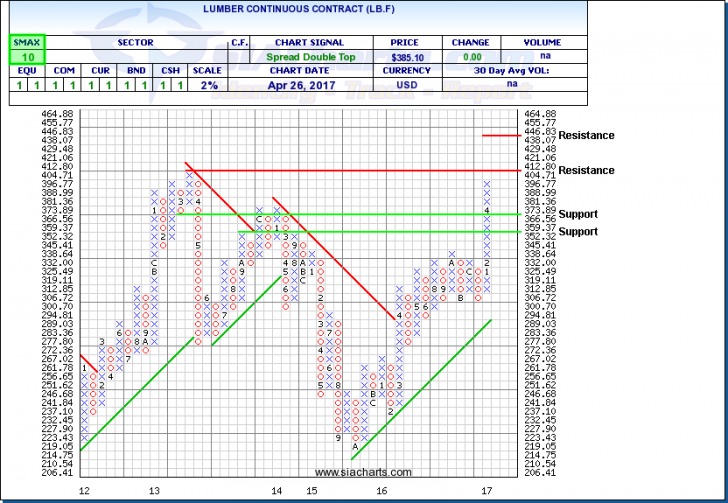For this week’s Equity Leaders Weekly, we are not short of things to write about, however will turn our attention specifically to U.S./Canada trade relations, the impact on the United States Dollar/Canadian Dollar (USDCAD), and the implication on specific sectors that may be influenced by the Trump administration moving forward. We will begin by exploring the recent movement in the USDCAD relationship and then turn our attention to the Lumber Continuous Contract (LB.F) and explore the impact this cross border relationship is having on a specific sector that is vital to the Canadian Economy and employment, especially in the western provinces.
United States Dollar/Canadian Dollar (USDCAD)
Holding true to his beliefs that protectionist policies will keep “jobs and wealth inside the United States,” President Donald Trump and his administration have caused a flurry of activity within the currency markets over the past few trading days. The Canadian Dollar shed more than a cent as news of the tariffs initially spread. Monday’s announcement regarding softwood lumber tariffs, following Mr. Trump attacking Canada on the what he calls “price fixing” within its dairy industry, which was just the start. On Wednesday, it was revealed that the President and his administration have prepared a draft executive order to withdraw from the North America Free Trade Agreement completely.
A week ago, the U.S. President called NAFTA a “disaster,” stating Tuesday at the White House “People don’t realize, Canada’s been very rough on the United States. People always think of Canada as being wonderful – so do I, I love Canada – but they’ve outsmarted our politicians for many years.” An order of this nature would not immediately pull the U.S. from NAFTA, however this might give Canada and Mexico a six-month notice period of the US’s intent to withdraw. The immediate impact on the Canadian Dollar with all of this coming from south of the border has been one of immediate and continued weakness so far.
The last time we looked at the United States Dollar/Canadian Dollar (USDCAD) relationship was on January 18th, 2017. At the time the USDCAD was in a falling column of O’s and sitting right at support of ~1.30. Now the tides have turned and we are back into a rising column of X’s and once again approaching a rather strong level of resistance between at 1.3645. A push through this level could see the next level of resistance at ~1.40 and then at the upper range of 1.4629, if we see continued weakness for the Canadian Dollar. Support can still be found just past 1.30 and then again at 1.2601.

Lumber Continuous Contract (LB.F)
It should be noted that the last time we explored the Lumber Continuous Contract (LB.F) specifically in the ELW was back in January of 2010. However, recall we made mention of the recently expired 10-year old Soft Lumber Trade Agreement in our publication from November 10, 2016, titled “Opportunities in a Changing World” (For SIACharts' subscribers this can be found under the Marketing › Materials area). In this article, we reference a few points of concern regarding President Trump’s anticipated protectionist measures. This week, Mr. Trump and his administration delivered this anticipated announcement regarding the intention to levy a 20% tariff against soft wood lumber imports.
As mentioned above, the Canadian Dollar fell immediately, setting off a new wave of weakness. Correspondingly, we saw the LB.F trade with some weakness as well. However, we saw specific lumber companies trade to the upside. This came as a surprise to some, although not to the lumber producers themselves who may have priced in the lumber duties in advance with some market participants seeing 20% as “low” relative to a tariff that could have been much higher or they were anticipating. Upon closing Tuesday, a few lumber producers were up significantly in the face of a weakening dollar: Canfor was up 9.46% with West Fraser closing up 8.5%.
For the most part, LB.F has seen continued strength through 2017 so far, with a move of 25% to the upside since February alone. Although a bit of selling has taken place in the face of the new tariff announcement, relative strength still prevails. Currently approaching resistance at 412.80, LB.F is approaching levels not seen since the mid 2000’s and a push through 412.80 could see resistance next at 446.83. Support comes in at 366.56 and 352.32. With a positive SMAX of 10, LB.F is exhibiting near-term strength across the asset classes.

SIACharts.com specifically represents that it does not give investment advice or advocate the purchase or sale of any security or investment. None of the information contained in this website or document constitutes an offer to sell or the solicitation of an offer to buy any security or other investment or an offer to provide investment services of any kind. Neither SIACharts.com (FundCharts Inc.) nor its third party content providers shall be liable for any errors, inaccuracies or delays in content, or for any actions taken in reliance thereon.
For a more in-depth analysis on the relative strength of the equity markets, bonds, commodities, currencies, etc. or for more information on SIACharts.com, you can contact our sales and customer support at 1-877-668-1332 or at siateam@siacharts.com.














